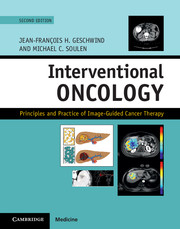Book contents
- Frontmatter
- Contents
- List of contributors
- Section I Principles of oncology
- Section II Principles of image-guided therapies
- Section III Organ-specific cancers – primary liver cancers
- Section IV Organ-specific cancers – liver metastases
- Section V Organ-specific cancers – extrahepatic biliary cancer
- Section VI Organ-specific cancers – renal cell carcinoma
- Section VII Organ-specific cancers – chest
- Section VIII Organ-specific cancers – musculoskeletal
- Section IX Organ-specific cancers – prostate
- 27 Prostate ablations
- Section X Specialized interventional techniques in cancer care
- Index
- References
27 - Prostate ablations
from Section IX - Organ-specific cancers – prostate
Published online by Cambridge University Press: 05 September 2016
- Frontmatter
- Contents
- List of contributors
- Section I Principles of oncology
- Section II Principles of image-guided therapies
- Section III Organ-specific cancers – primary liver cancers
- Section IV Organ-specific cancers – liver metastases
- Section V Organ-specific cancers – extrahepatic biliary cancer
- Section VI Organ-specific cancers – renal cell carcinoma
- Section VII Organ-specific cancers – chest
- Section VIII Organ-specific cancers – musculoskeletal
- Section IX Organ-specific cancers – prostate
- 27 Prostate ablations
- Section X Specialized interventional techniques in cancer care
- Index
- References
Summary
Introduction
In the last decades, the incidence of prostate cancer tripled to 152 new cases of prostate cancer per 100,000 men in 2013. Among cancer in men, it is the third most common cause of death in men, with 23 per 100,000 men/year. A better understanding of prostate cancer biology and earlier detection with prostate-specific antigen (PSA) screening and imaging have contributed to interest in less invasive alternatives to surgical resection.
Focal tumor ablation has been increasingly used for local control or with curative intent in solid-organ tumors such as kidney, thyroid, breast, liver, and lung. While stimulating thought about ablation application in prostate cancer, clinical application has been limited despite encouraging functional and short-term oncological outcomes. Furthermore, despite evidence that men with low-risk localized prostate cancer may not benefit from treatment in terms of prostate cancer-specific mortality, many men still elect to undergo radical treatment. For these patients, minimally invasive options that could provide oncologic efficacy with little impact on quality of life may be attractive. More importantly, focal ablation of intermediate-risk tumors may enable more men to remain on active surveillance, thereby sparing them the consequent harms associated with radical treatment, including sexual, urinary, and bowel complications.
Prostate ablation is an emerging treatment modality offering promise for local cancer control with reduced morbidity relative to alternatives. The image-guided nature of focal ablation techniques is particularly appealing as preservation of erectile, urinary, and rectal function can be achieved by minimizing damage to the neurovascular bundles, external sphincter, bladder neck, and rectum. The reality, however, is that ablation strategies have not been standardized in the prostate. A trend toward targeted treatments in men with smaller tumor volume and away from whole- or half-gland therapy has been observed. One explanation is that the natural history of the disease is driven by the largest lesion with the highest grade, the so-called “index lesion,” and not by the presence of multiple foci of disease observed in surgical series. Improvements in imaging techniques, particularly magnetic resonance imaging (MRI), now enable visualization of small foci of prostate cancer. Whether focal ablation should play an increasing role in prostate cancer management is a matter of ongoing debate, though clinical outcomes after treatment of smaller-volume disease in other organs have been encouraging.
- Type
- Chapter
- Information
- Interventional OncologyPrinciples and Practice of Image-Guided Cancer Therapy, pp. 265 - 282Publisher: Cambridge University PressPrint publication year: 2016



